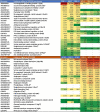Comparative secretome analysis of Staphylococcus aureus strains with different within-herd intramammary infection prevalence
- PMID: 35030987
- PMCID: PMC8765078
- DOI: 10.1080/21505594.2021.2024014
Comparative secretome analysis of Staphylococcus aureus strains with different within-herd intramammary infection prevalence
Abstract
Staphylococcus aureus is a major pathogen causing intramammary infection and mastitis in dairy cows. S. aureus genotypes (GT) can differ significantly in their ability to diffuse and persist in the herd; while the association of virulence gene carriage with epidemiological behavior remains unclear, a role for secreted proteins has been postulated. We characterized the secretome of six S. aureus strains belonging to two genotypes with opposite within-herd prevalence, GTB (high) and GTS (low), corresponding to sequence types (ST) 8 and 398, by high-resolution tandem mass spectrometry and differential analysis with Proteome Discoverer. Data are available via ProteomeXchange with identifier PXD029571. Out of 720 identified proteins, 98 were unique or more abundant in GTB/ST8 and 68 in GTS/ST398. GTB/ST8 released more immunoglobulin-binding proteins, complement and antimicrobial peptide inhibitors, enterotoxins, and metabolic enzymes, while GTS/ST398 released more leukocidins, hemolysins, lipases, and peptidases. Furthermore, GTB/ST8 released the von Willebrand factor protein, staphylokinase, and clumping factor B, while GTS released the staphylococcal coagulase and clumping factor A. Hence, GTB/ST8 secretomes indicated a higher propensity for immune evasion and chronicity and GTS/ST398 secretomes for cellular damage and inflammation, consistent with their epidemiological characteristics. Accordingly, GTS/ST398 secretions were significantly more cytotoxic against bovine PBMCs in vitro. Our findings confirm the crucial role of extracellular virulence factors in S. aureus pathogenesis and highlight the need to investigate their differential release adding to gene carriage for a better understanding of the relationship of S. aureus genotypes with epidemiological behavior and, possibly, disease severity.
Keywords: Proteomics; bacterial virulence; dairy cow; immune evasion; inflammation; intramammary infection; mammary gland; mastitis.
Conflict of interest statement
No potential conflict of interest was reported by the author(s).
Figures







References
-
- Cosandey A, Boss R, Luini M, et al. Staphylococcus aureus genotype B and other genotypes isolated from cow milk in European countries. J Dairy Sci. 2016;99:529–540. - PubMed
-
- Gazzola A, Maisano AM, Bianchini V, et al. Short communication: characterization of Staphylococcus aureus from bulk tank milk of dairy cattle in Lombardy (northern Italy). J Dairy Sci. 2020;103:2685–2692. - PubMed
-
- Graber HU, Naskova J, Studer E, et al. Mastitis-related subtypes of bovine Staphylococcus aureus are characterized by different clinical properties. J Dairy Sci. 2009;92:1442–1451. - PubMed
Publication types
MeSH terms
LinkOut - more resources
Full Text Sources
Medical
Molecular Biology Databases
Miscellaneous
